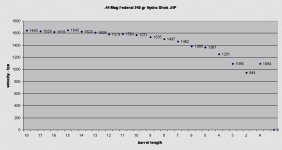I think you will find some such data on the web.
(But maybe not for the 500 S&W)
For instance:
BBTI - Ballistics by the Inch :: Calibers/Cartridges
The loss of velocity, compared to whatever longest barrel you have,
gets greater and greater (per inch) as the barrel gets shorter.
In other words the velocity is a logarithmic curve as shown in the diagrams below.
The greatest loss is going from 3" to 2", then 4" to 3" etc.
(The equation for the Federal 240 below is 804.9+311.8*LN(x))
.500 S&W Magnum - Wikipedia
Has some 8" vs. 18" velocity results but finding someone who has actually cut a long 500 S&W barrel down inch by inch is more challenging.
That's a big project.
https://www.luckygunner.com/lounge/revolver-velocity-vs-barrel-length/
Went the easy route and tested several revolvers of different lengths and makers with the same commercial rounds and plotted the results.
These are all .38 spl or .357 but you will get the idea.
Sorry I can't be more specific to the 500 S&W.
As a shooter of the 500's smaller brother, the 445, my main concern with barrel length is the recoil.
However my shortest barrel is 8" so I don't have anything shorter to compare it with.
I could not afford the Dan Wesson barrel pack at the time.
My others are 12" and 17" respectively (in an Encore)
I doubt I would be able to shoot a 4" 500 with a full heavy load these days.
Going from the 7.5" Redhawk to the 4" light barrel 629 in 44 mag feels like doubling the recoil.
I don't know how anyone shoots the aluminum 44 mags.
My aluminum 44 special feels like a full house magnum.


